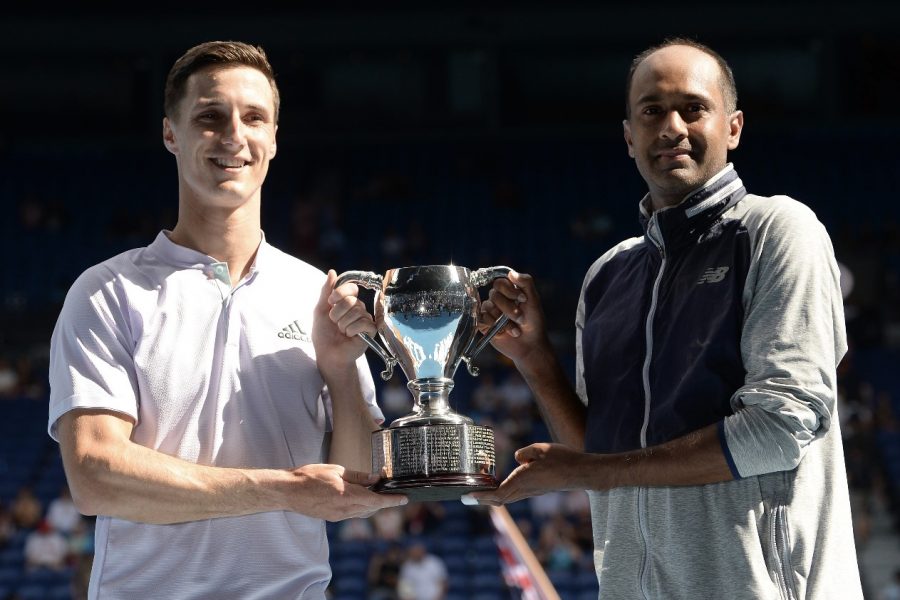NCAA may look to professionals for tennis rule changes
Joe Salisbury (left) and Rajeev Ram pose with their trophy after the pair won the Australian Open men’s doubles competition on Feb. 2. The NCAA looks to professionals such as the pair to make new rules for tennis.
August 27, 2020
For most of the sports world, the global outbreak of COVID-19 was perceived as a rude interruption to the flow of the calendar. However, in the case of professional tennis, the sudden stoppage may end up as a major turning point in the sport’s history, with the potential of rule changes when play resumes.
Prior to COVID-19, professional tennis had often been critiqued for its slow pace and focus on tradition, rather than adapting to new times. While professional tennis traditionally only has a six-week offseason, the season’s abrupt end in March provided the tennis community the ability to collectively exhale and take stock of their sport. With the future of tennis in mind, players and organizers utilized their time off to make strides toward positive change by planning and executing small events with new and exciting rule structures.
Potentially the most successful of these new structures has been that of the Ultimate Tennis Showdown, a set of small men’s and women’s events that occurred in France over the summer. The events were a resounding success in terms of viewership in large part due to their unique rule format. It included changes such as four 10-minute quarters of nonstop play, each worth one point followed by overtime if the score is tied 2-2, a 15-second clock between points and the largest twist being the so-called “UTS cards.”
The “UTS cards” are a set of special playing cards that are randomly dealt to each competitor and can be used strategically throughout a match. The cards contain varying effects such as skipping an opponent’s serve and making certain points count as double or triple.
While it’s unlikely something like “UTS cards” could make it into collegiate tennis due to their complex nature, the aspects of the UTS focused on speeding up matches could prove practical within NCAA tennis. Currently, college tennis faces similar issues to professional tennis in terms of match length, as college matches typically take hours to complete.
Get The Daily Illini in your inbox!
Implementing the UTS’s format of four 10-minute quarters could be seamless, as matches could still be scored in their typical fashion of the single doubles point, followed by six singles matches. The only difference would be points would be earned by winning three of four quarters rather than two or three sets.
One final benefit to implementing a quarter system would be a major uptick in exciting overtime matches, as tying two quarters to two quarters is easier to achieve than reaching overtime by tying 6-6 in a typical set.
While many organizers used the time off their normal schedule to hold a variety of different small events, the time off has also helped individual players crystalize their own opinions on the sport’s future. One such example is University of Illinois’ alumnus and Olympic silver medalist, Rajeev Ram.
To Ram, the future of tennis may be in emphasizing doubles play.
“I love the team format of tennis,” Ram said. “If we can figure out a way to implement more team competitions in tennis — more team competitions that really were a cornerstone of our sport — I think that could really drive our sport forward because I think it’s just really cool. Tennis is so individual as it is and if we can put that in place somehow, I think that could be something (impactful) for the future of tennis.”
While NCAA matches do include a doubles point, it only accounts for one point compared to the six available points from winning singles matches. One potential change could be making each individual doubles match worth one point for a total of three doubles points rather than only the team winning the majority of the three doubles matches receiving a single point.
In the upcoming spring season, college tennis will likely look the same as before, outside of COVID-19 related changes. That sameness may not last forever, as professional tennis now has real momentum behind significant changes to tournament play. In recent years, the major tennis tours have begun to warm up to change, as the relatively new Next Gen ATP Finals boasts a unique, faster scoring structure. With the success of the UTS and a growing number of players seeking change, the tide may soon turn towards a newer, faster-paced game of tennis. Only time will tell.
@WesHollenberg







